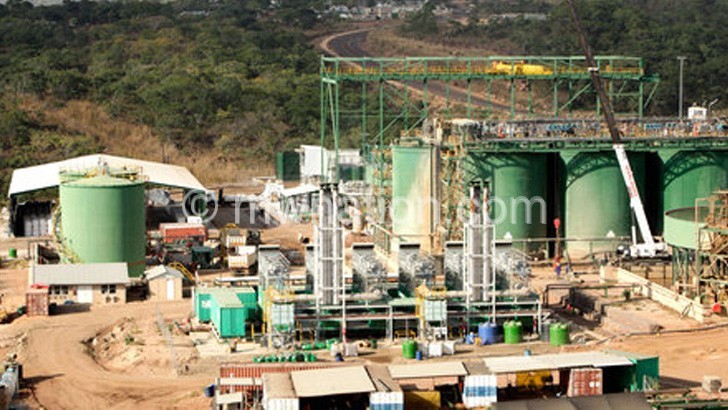Hope for Kayeleke
Paladin Africa Limited (PAL), operator of Kayelekera Uranium Mine (KUM) in Karonga, has hinted on the possibility of resuming operations at the mine on the back of rising uranium prices on the global market
In its quarterly activities report for the period ending March 31 2017, dual-listed Paladin Energy, which holds mineral rights for the Kayelekera area, said it is discussing with external consultants with respect to potential to prepare a “re-start project implementation plan”.

“The aim of this work is to establish a definitive plan for a re-start, including updated capital expenditure and cost estimates, together with detailed implementation schedule,” Alexander Molyneux, PAL chief executive officer is quoted in the report as saying.
Kayelekera began production in 2009 and in 2013, revenues from the mine alone contributed 2.6 percent to gross domestic product (GDP).
Paladin Energy, put the mine on care and maintenance in 2014 following the slump in the price of the yellow cake in the aftermath of the Fukushima nuclear disaster in Japan, which resulted in the closure of several nuclear plants in Asia.
Following the Fukushima disaster, the spot price of the yellow cake dropped from $72 to $35 per pound.
After the mine was closed in 2013, the mining sector’s contribution to the GDP went down from around eight percent in 2009 to one percent in 2016.
Revenue generated from the mining sector has declined by 90.5 percent from K1.7 billion in 2013 to K161 million in 2016.
Asked on when exactly KUM will reopen, Paladin Africa Limited consultant and senior adviser Grain Malunga said on Wednesday that key to reopening of the mine are uranium prices on the global market.
“Prices should pick up to $60/lb to cater for the company’s operation costs,” he said.
“Currently, we are just looking after the plant to ensure that it does not deteriorate. The moment the prices of uranium pick up above operating cost, then we can re-start operations. So far, prices are picking up, but not to the levels where they can sustain production.
“We are eyeing over $60/lb as it costs about $40/lb per pound to produce uranium at the mine,” explained Malunga.
Malawi Confederation of Chambers of Commerce and Industry (MCCCI) chief executive officer Chancellor Kaferapanjira said the possibility reopening of Kayelekera Mine is good news for the economy.
Said Kaferapanjira: “Rather than retrenchment of employees and loss of foreign exchange, which Malawi has suffered as a result of the closure of the mine in 2014, there were a number of indirect economic costs to the Malawi economy which are perhaps several-fold than what the common eye would see.
“Kayelekera had become an urban centre from nowhere and now stands almost like a ghost town. Prices of supplies to the people working at this mine, such as food supplies, accommodation, etc, bottomed because of a decline in demand. Some companies, for instance, vehicle suppliers, fuel suppliers and suppliers of spare parts for that matter, thinned because of a loss of a large share of their market.
“In other words, the linkages the mine had created were heavily reduced and now have a chance to rebound. We can, therefore, only see positive news coming out of this possible good news.”
The MCCCI chief said right now, the price of uranium is hovering around $22.50 per pound compared to $33.50 per pound, but this is an increase from $18.50 per pound reached in November 2016.
“But as a matter of fact, the price of uranium is projected to double by 2018 as negative sentiments surrounding this commodity have now waned and there are more reactors being built in addition to existing ones being rehabilitated to be used for production of clean energy,” Kaferapanjira said.
He said so far, Japan has succeeded in bringing some of its reactors back.
“Four of its reactors have already restarted operations, and the world is building more nuclear reactors right now than ever before, with a total of 65 new reactors already going up, another 165 planned and yet another 331 proposed. All this is good news for Kayelekera Mine and portends a promising future for Malawi and its economy,” he explained.
According to the figures in the Annual Financial Report 2010, mining exports were worth $114 million in 2010, equivalent to 10 percent of all exports, and $123 million in 2011.
In August 2012, Paladin said it invested more than $500 million in the mine, creating 2 5000 jobs, 84 percent of which went to Malawians.
However, in January 2013, Paladin announced the retrenchment of 110 workers at the mine due to falling uranium prices. It then reduced its Malawi national workforce by 18 percent and its expatriate positions from 118 to 90.
Out of the total production in 2010, the company exported 726 088.89 kilogramme (kg) of uranium concentrates (yellow cake) worth $113.4 million (K 17.246 billion).
The export of this consignment earned the Malawi Government up to K272.3 million in terms of royalties (calculated at 1.5 percent of the total gross value of exported consignment). Paladin’s 2012 Annual Report shows that the company paid $9.6 million (about K1.5 billion at $1 to K152 exchange rate) to the government in “a variety of government taxes”.
In an interview yesterday, economist and lecturer in economics at the Catholic University, Gilbert Kachamba, said the reopening of Kayelekera will help in reducing unemployment as activities at the mine create a lot of employment for Malawians, but he had doubts about the mine’s contribution to government revenue streams.
“Kayelekera Mine, for a start, has benefited very few Malawians because of the way everything was designed,” he said.
In recent years, mining sector commentators have noted that although Malawi’s mining sector is booming, it is still riddled with too many flaws in the legal framework that are creating the leakage for potential tax collection. The Mining Act is currently being reviewed. n





